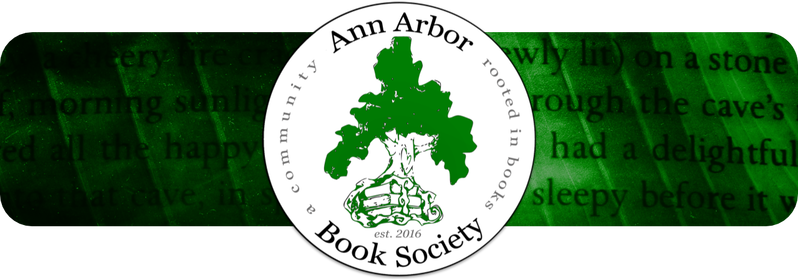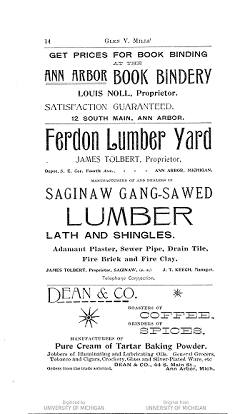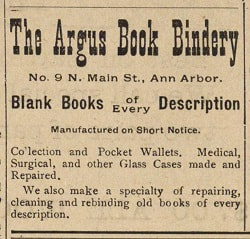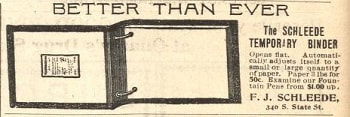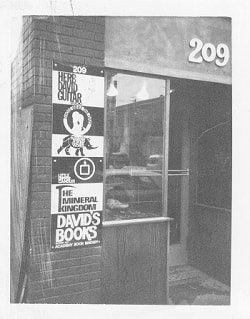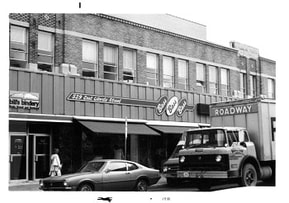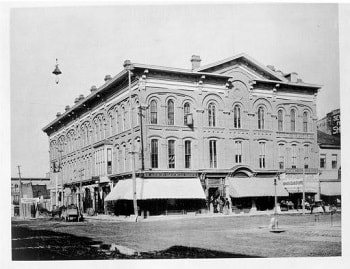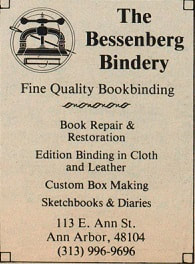A Bookbinding Tour of Ann Arbor
by Karen Alvarez
The elegant and intricate covers that we typically associate with bookbinding bely the dangers faced by practitioners. A man named Frank Johnston, a bookbinder with the Ann Arbor Printing Company, made news in 1902 when he suffered a gruesome injury from a book saw. His doctor was quoted as hoping “to be able to save the hand, but an amputation of one or more fingers will be necessary.”
On site at the paper mill was a book bindery, whose proprietor Elijah Booth advertised in 1843 that “old books will be neatly rebound on short notice…country produce taken in payment.” Four years later he moved his bindery to “No. 5 Huron Block, opposite the Washtenaw House.” The Huron Block was part of a growing commercial district on Broadway, and the Washtenaw House was a prominent hotel and stagecoach stop between Chicago and Detroit.
Start here if you’re continuing this article from the September newsletter…
The area declined after the center of town shifted south to the growing university campus. Most of the original buildings have since disappeared, however, you can still glimpse a bit of what bookbinder Booth would have seen across the street from his studio; the Anson Brown Building at 1001 Broadway (now the St. Vincent de Paul thrift shop) is the city’s oldest commercial structure.
Newspaper advertisements reveal the many jobs that people requested aside from binding books:
“County Records, Ledgers, Journals, and all kinds of Blank Books made to order…Pamphlets and Periodicals bound in a neat and durable manner” (Michigan Argus, 1860)
“All kinds of records, ledgers, journals, magazines, ladies’ books, rurals and Harper’s Weeklies, etc…music especially bound more tastefully than at any other bindery in Michigan.” (Ann Arbor Courier, 1892)
Take a walk or a drive around downtown and you will pass the sites of bookbinderies from long ago and more recent times. The following route starts on South State, continues west on Liberty to Main, and continues north to Kerrytown:
316 S. State (Currently Red Hawk Bar & Grill): Wahr’s Bookstore was a local legend that dominated the downtown commercial landscape for almost ninety years until closing in 1975. It tried a few locations in the area before settling its flagship here and a satellite store on North Main. Wahr’s was a major textbook seller in addition to offering bookbinding, printing, stationery, and even wallpaper and sporting goods.
306 S. State (Currently unoccupied, located next door to Ben & Jerry’s): “There is a war brewing on S. State St. It is all caused by Skinner, the bookbinder,” newspapers announced in September 1898. James Skinner had worked in the Argus bindery before establishing his own workshop. Soon after opening at this location, he angered the business owner next door at 308 S. State by erecting a large sign between the two buildings. The irate neighbor sued Skinner for $100 in damages (about $3100 in today’s terms). They eventually settled their differences and stayed in their respective buildings for more than ten years.
200-202 S. Main (Currently BD’s Mongolian Grill): A bookbinder named George Dengler operated a studio on the upper floor in the early 1900s. Like many of his contemporaries, he started his career in a large newspaper publishing house and worked his way up to foreman of the Courier bindery before opening his own business.
112 S. Main (Currently Vinology): The Mayer & Schoettle bookbindery opened in 1909. A few years and one partnership change later, the renamed Mayer-Schairer Company expanded its services to include printing and office supplies. It remained a local favorite until it closed in 2002.
12 S. Main (Old street number system, currently Vinology): Only one bindery was ever named for the city. The Ann Arbor Book Bindery, despite the grandness of its name, was a small operation owned by Louis Noll on the upper floor of the building. He had worked as the foreman of the Courier bindery in the 1880s before striking out on his own.
The area between Main Street and Fifth Avenue north of Huron hosted a cluster of bookbinderies both large and small:
Huron and Fourth Ave: Yet another newspaper/bookbinding business could be found one block east of the old Masonic Block. The Register Publishing Company operated from an imposing building on the northeast corner of Huron and Fourth. Known as the Hamilton Block (later the Allenel Hotel), the building stood for just over fifty years until it was razed in 1936.
301 N. Main: The building now home to the Ann Arbor Area Community Foundation is one of the city’s oldest surviving commercial structures. Known as Dr. Chase’s Steam Printing House, it was the headquarters of the Courier news and bookbindery from the 1860s, and later the Ann Arbor Printing Company.
410 N. Fourth: Our last stop on this tour of downtown bookbinding spots takes us to the Kerrytown Shops. Hollander’s was Ann Arbor’s most prominent bookbinding and decorative paper business for thirty years. It offered a large inventory of craft and bookbinding supplies on the main store level, and held bookbinding and paper art workshops on the lower level. The owners of Hollander’s decided to close the bricks-and-mortar store in 2020 but announced their intention to continue selling products online.
